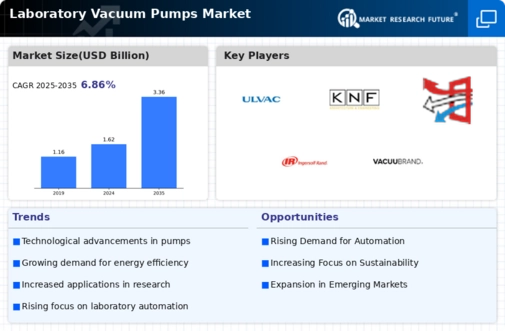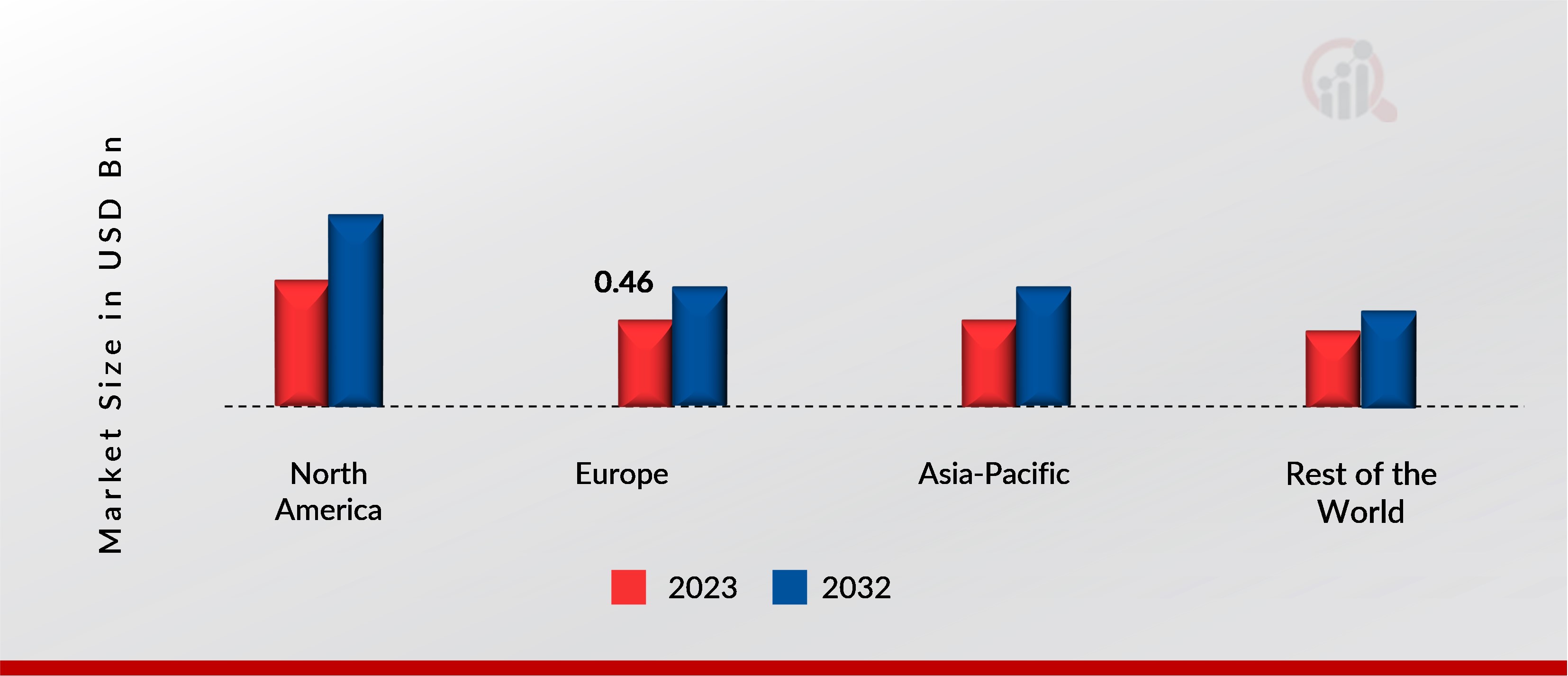Market Analysis
Laboratory Vacuum Pumps Market (Global, 2024)
Introduction
The laboratory vacuum pumps market is expected to play a crucial role in various scientific and industrial applications, driven by the increasing demand for efficient and reliable vacuum solutions across laboratories and research centers. The market is witnessing a shift toward high-tech systems that are designed for specific needs, such as chemical analysis, material processing, and environment testing. Also, the rising R&D activities in the pharmaceuticals, biotechnology, and materials science industries is expected to boost the demand for laboratory vacuum pumps, as these devices are essential for maintaining the integrity of experimental results and maintaining the required conditions for the experiment. Furthermore, the growing awareness about energy conservation and sustainable development is driving manufacturers to develop eco-friendly vacuum pump solutions, thereby shaping the market dynamics. As the laboratory vacuum pumps market continues to evolve, it is essential for manufacturers to understand the trends, challenges, and opportunities.
PESTLE Analysis
- Political
- The laboratory vacuum pump market in 2024 is mainly affected by political factors such as government regulations and policies, and scientific research and development. In the United States, for example, the National Institutes of Health (NIH) has allocated 45 billion US dollars to fund scientific research, which will directly affect the demand for laboratory equipment, including laboratory vacuum pumps. The market is also affected by the tariffs on imported laboratory equipment. For example, the United States has imposed a tariff of up to 25% on some imported scientific instruments, which may increase the cost of manufacturers and consumers.
- Economic
- In 2024 the world's economy was steadily expanding. Research and development expenditures in all industries rose from $800 billion to $1.8 trillion. The resultant increase in demand for laboratory apparatus and vacuum pumps was expected to spur demand for advanced technology. In addition, the unemployment rate in the United States was expected to stay low, at a projected 3.5 percent, which would mean greater spending on research and development in both the public and private sectors, which would further stimulate the market for laboratory vacuum pumps.
- Social
- In 2024, the trends in the social sphere indicate an increasing concern for the environment, for the preservation of the environment, and for the preservation of the earth. Approximately seventy percent of scientists now practice environmentalism in their laboratories, which also includes the use of energy-efficient laboratory equipment. This trend is likely to lead to a higher demand for vacuum pumps that are designed to minimize energy consumption and minimize the environment. Also, the increasing focus on laboratory safety is leading to higher equipment standards, which will also influence the purchase decision.
- Technological
- The laboratory vacuum pump market will be transformed by technological developments by 2024. Among the most popular developments are smart vacuum pumps equipped with IoT, enabling real-time monitoring and data analysis. By 2025, the market for smart laboratory equipment is expected to reach $ 12 billion, indicating a strong trend towards automation and connectivity in the laboratory. Also, the development of materials is leading to the development of more durable and efficient vacuum pumps, improving their performance and service life.
- Legal
- The market for laboratory vacuum pumps is subject to various legal regulations in 2024, especially in the area of safety and the environment. The Occupational Safety and Health Administration (OSH) has established regulations that require laboratory equipment to meet certain safety standards. These regulations have a direct influence on the design and manufacturing of vacuum pumps. The compliance with these regulations often requires additional investment, and companies spend an average of $ 1,200,000 a year on compliance-related activities. Intellectual property rights are also an important tool for protecting innovations in the field of vacuum pumps.
- Environmental
- The laboratory vacuum pump market will be increasingly influenced by the environment by 2024. In the name of sustainable development, the global trend towards a reduction in greenhouse gas emissions is reflected in stricter regulations on the reduction of greenhouse gas emissions. The European Union has launched the Green Deal with the goal of reducing greenhouse gas emissions by at least 55% by 2030. In this legal environment, manufacturers are developing not only energy-saving vacuum pumps, but also vacuum pumps made of reclaimed materials. A significant change in the practices of laboratories is already visible. Almost 40% of laboratory managers now have a clear preference for buying environmentally friendly equipment.
Porter's Five Forces
- Threat of New Entrants
- The market for laboratory vacuum pumps is characterised by medium barriers to entry, due to the need for specialised technology and the compliance with regulatory standards. While the market is dominated by established companies, new entrants can still find opportunities by offering innovative solutions or by focusing on a niche market. However, the high capital outlay required for research and development may discourage some potential new entrants.
- Bargaining Power of Suppliers
- The bargaining power of the suppliers in the market for laboratory vacuum pumps is relatively low. There are numerous suppliers of raw materials and components, which makes the market highly competitive. If prices rise or quality declines, manufacturers can easily change suppliers. However, many companies are vertically integrating to control their supply chains even better.
- Bargaining Power of Buyers
- The bargaining power of the buyers in the laboratory vacuum pump market is very high because of the availability of many products and the easy comparison of products. Large laboratories and research institutions often buy in large quantities, which can give them an advantage in negotiating prices and terms. Moreover, cost-efficiency in R & D has become more important, so buyers are looking for the best deal.
- Threat of Substitutes
- The threat of a substitute for the laboratory vacuum pumps is moderate. There are alternative products such as diaphragm pumps and rotor pumps, but they may not be as effective or efficient in certain applications. There is a possibility that, with the development of technology, more effective substitutes will be developed and the vacuum pump industry will be threatened.
- Competitive Rivalry
- Competition is fierce in the laboratory vacuum pumps market. Several leading players compete for market share. To differentiate their products, these companies constantly seek to improve and expand their product lines. Price competition is also intense, as companies try to lure customers with similar products. The resulting price wars and increased marketing expenditures can have a negative effect on market growth.
SWOT Analysis
Strengths
- High demand in research and development sectors for precise vacuum applications.
- Technological advancements leading to improved efficiency and energy savings.
- Diverse applications across pharmaceuticals, biotechnology, and environmental testing.
Weaknesses
- High initial investment costs for advanced vacuum pump systems.
- Maintenance and operational costs can be significant over time.
- Limited awareness of vacuum pump technology among smaller laboratories.
Opportunities
- Growing trend towards automation in laboratories, increasing demand for integrated vacuum solutions.
- Expansion of the biotechnology and pharmaceutical industries in emerging markets.
- Potential for innovation in eco-friendly and energy-efficient vacuum pump designs.
Threats
- Intense competition from low-cost manufacturers, particularly in developing regions.
- Economic fluctuations affecting laboratory budgets and spending.
- Regulatory changes impacting manufacturing standards and operational practices.
Summary
Lab Vacuum Pumps Market will be characterized by strong demand, technological advancements, and diverse applications in various industries. High initial costs and maintenance issues are the major restraints to the market. Opportunities are expected from increasing automation trends and expansion into emerging markets. However, the market is vulnerable to competition and economic fluctuations. Strategic focus on innovation and cost-effective solutions will help the market leaders navigate the changing environment.








Leave a Comment